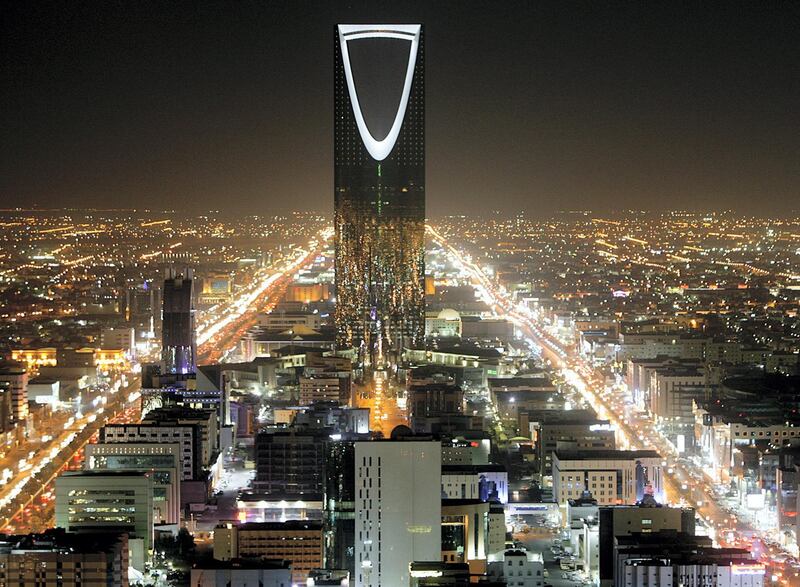Saudi Arabia yesterday revealed its 2019 annual budget, the kingdom's largest, as the world's biggest oil exporter boosts spending to spur economic growth.
The kingdom, the biggest Arab economy, estimated spending in 2019 would reach 1.106 trillion riyals (Dh1.083tn), up 7 per cent from the finance ministry's figure of 1.030tn riyals for 2018.
“Saudi government’s spending is the main driver of growth. The idea is to stimulate the growth of the private sector,” said Mazen Alsudairi, head of research at Al Rajhi Capital in Riyadh.
Saudi Arabia expects to continue the spending spree in 2020 and beyond with government expenditures reaching 1.143tn riyals in 2020 and 1.17tn riyals in 2021.
The fiscal deficit is forecast to narrow to 4.1 per cent of GDP in 2019 from an estimated 5 per cent in 2018, at 131 billion riyals. The government plans to lower the fiscal deficit to reach 3.7 per cent of GDP in 2021 and balance the budget by 2023.
Revenues are expected to rise next year to 975bn riyals, a 9 per cent increase from this year, Saudi state-run news agency SPA said.
They are expected to continue to grow to reach 1.045tn riyals in 2021, with an average annual growth rate of 6 per cent, the government said in its medium-term estimate released at the end of September.
The contribution of non-oil revenue to total revenue for Saudi Arabia has increased to 32 per cent in 2018 from 12 per cent in 2014. Growth of non-oil revenue reached 20 per cent during this period. Oil revenue are estimated at 662bn riyals in 2019 compared with 607bn riyals in 2018, an increase of 9 per cent, said Minister of Finance, Mohammed Al Jadaan.
“The majority of the growth in revenue is coming from oil. We believe the average oil price in 2018 was $65 per barrel,” Mr Alsudairi said. “According to our calculations the government needs about $70 a barrel to hit oil revenue expected in 2019.”
Saudi Arabia’s real gross domestic product is expected to expand 2.3 per cent in 2018, after shrinking 0.7 per cent in 2017. It is expected to grow 2.6 per cent in 2019, said the minister.
The kingdom is going through a major economic transformation and is implementing reforms under its Vision 2030 agenda to help wean the country off oil and create new revenue streams.
Saudi Arabia, which still relies on the sale of hydrocarbons to fund its economy, cut spending and borrowed from international and domestic markets following the three-year oil price slump, which saw Brent prices fall below $30 per barrel in the first quarter of 2016.
Brent prices are hovering around $60 per barrel, boosting Riyadh’s ability to maintain spending.
___________
Read more:
Saudi Arabia unveils biggest ever budget to propel growth
Saudi Arabia's budget deficit narrows to 8.9% for 2017
___________
The deficit is expected to continue to rise slightly in 2020 to 138bn or 4.2 per cent of GDP, and decline gradually over the medium term until it reaches fiscal balance by 2023, the finance ministry said in its pre-budget estimates at the end of September.
“Higher oil prices explain most of the surprise,” Ziad Daoud, a Bloomberg economist said. “Saudi Arabia also increased its oil production by an average of 300,000 barrels per day this year when compared with 2017, providing a further boost.”
The kingdom will continue to provide allowances to Saudi citizens in 2019, similar to payments made this year. King Salman on Tuesday issued a decree to dispense monthly allowances for a year to help lower the cost of living until social protection mechanisms are studied, SPA reported.
State employees and military personnel will receive a 1,000 riyals-per-month living allowance for a year, according to the royal decree.
“We expect the government to have exceeded the budgeted plans by $14bn (1.7 per cent of GDP). The royal handouts ordered early this year explain most of the expenditure overrun,” Mr Daoud said.
The government also ordered an allowance of 500 riyals for pensioners and 500 riyals for social security beneficiaries. Saudi students’ allowances will be increased by 10 per cent, according to the decree.
These royal handouts will help offset the increases in the cost of energy and electricity prices as well as the introduction of 5 per cent VAT at the beginning of the year.
The ministry of finance will continue to follow the policy of diversification of sources of finance, Mr Al Jadaan said. It is estimated that the public debt will reach 678bn riyals at the end of 2019, equivalent to 21.7 per cent of the GDP. Government deposits and reserves with the Saudi Arabian Monetary Authority are projected to reach 496bn riyals, or about 15.9 per cent of GDP.
Riyadh set a ceiling for public debt as a percentage of GDP at 30 per cent, when it announced the 2020 National Transformation Programme in June 2016. This percentage is low compared to the high debt of G20 countries. The government expects to continue financing the deficit through debt issuances, which are expected to reach about 22 per cent of GDP in 2019 and about 25 per cent of GDP in 2021, according to medium-term estimates.







